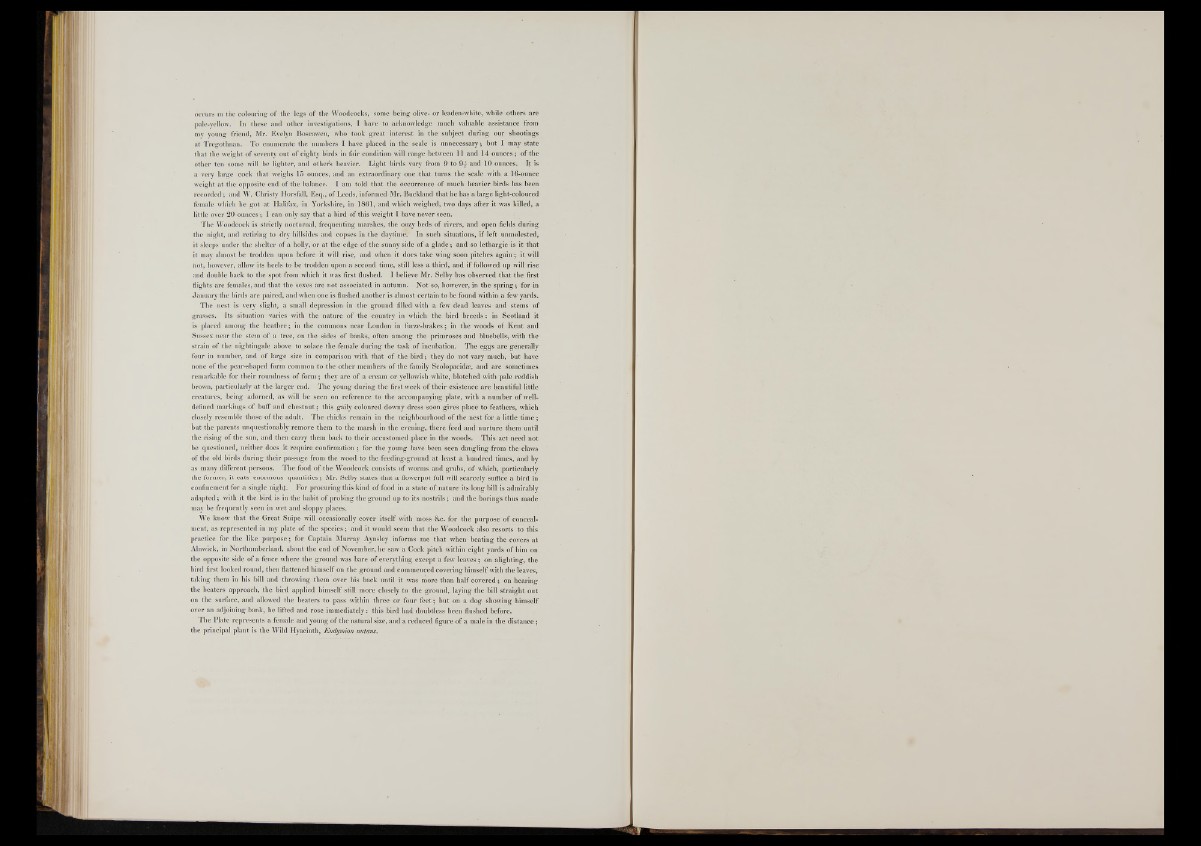
occurs m the colouring of the legs of the Woodcocks, some being olive- or leaden-white, while others are
pale-yellow. In these and other investigations, I have to acknowledge much valuable assistance from
my young friend, Mr. Evelyn Boscawen, who took great interest in the subject during our shootings
at Tregothnan. To enumerate the numbers I have placed in the scale is unnecessary; but I may state
that the weight of seventy out of eighty birds in fair condition will range between 11 and 14 ounces; o f the
other ten some will be lighter, and others heavier. Light birds vary from 9 to 9?-"and 10 ounces. .If is
a very large cock that weighs 15 ounces, and an extraordinary one that turns the scale with a 16-ounce
weight at the opposite end of the balance. I am told that the occurrence o f much heavier birds has been
recorded; and W. Christy Horsfall, Esq., o f Leeds, informed Mr. Buckland that he has a large light-coloured
female which he got at Halifax, in Yorkshire, in 1861, and which weighed, two days after it was killed, a
little over 20 ounces; I can only say that a bird of this weight I have never seen.
The Woodcock is strictly nocturnal, frequenting marshes, the oozy beds o f rivers, and open fields during
the night, and retiring to dry hillsides and copses in the daytime. In such situations, if left unmolested,
it sleeps under the shelter of a holly, or at the edge of the sunny side o f a glade; and so lethargic is it that
it may almost be trodden upon before it will rise, and when it does take wing soon pitches again; it will
hot, however, allow its heels to be trodden upon a second time, still less a third, and if followed up will rise
and double back to the spot from which it was first flushed. I believe Mr. Selby has observed that the first
flights are females, and that the sexes are not associated in autumn. Not so, however, in the spring; for in
January the birds are paired, and when one is flushed another is almost certain to be found within a few yards.
The nest is very slight, a small depression in the ground filled with a few dead leaves and stems of
grasses. Its situation varies with the nature o f the country in which the bird breeds: in Scotland it
is placed among the heather; in the commons near London in furze-brakes; in the woods of Kent and
Sussex near the stem of a tree, on the sides of banks, often among the primroses and bluebells, with the
strain o f the nightingale above to solace the female during the task of incubation. The eggs are generally
four in number, and o f large size in comparison with that of the b ird ; they do not vary much, but have
none of the pear-shaped form common to the other members o f the family Scolopacidse, and are sometimes
remarkable for their roundness of form ; they are o f a cream or yellowish white, blotched with pale reddish
brown, particularly a t the larger end. The young during the first week of their existence are beautiful little
creatures, being adorned, as will be seen on reference to the accompanying plate, with a number of well-
defined markings of buff and chestnut; this gaily coloured downy dress soon gives place to feathers, which
closely resemble those of the adult. The chicks remain in the neighbourhood of the nest for a little time ;
but the parents unquestionably remove them to the marsh in the evening, there feed and nurture them until
the rising of the sun, and then carry them back to their accustomed place in the woods. This act need not
be questioned, neither does it require confirmation ; for the young have been seen dangling from the claws
of the old birds during their passage from the wood to the feeding-ground at least a hundred times, and by
as many different persons. The food of the Woodcock consists of worms and grubs,- o f which, particularly
the former, it eats enormous quantities; Mr. Selby states that a flowerpot full will scarcely suffice a bird in
confinement for a single .night. For procuring this kind of food in a state o f nature its long bill is admirably
adapted; with it the bird is in the habit o f probing the ground up to its nostrils; and the borings thus made
may be frequently seen in wet and sloppy places.
We know that the Great Snipe will occasionally cover itself with moss &c. for the purpose o f concealment,
as represented in my plate of the species; and it would seem that the Woodcock also resorts to this
practice for the like purpose; for Captain Murray Aynsley informs me that when beating the covers at
Alnwick, in Northumberland, about the end o f November, he saw a Cock pitch within eight yards of him on
the opposite side of a fence where the ground was bare of everything except a few leaves; on alighting, the
bird first looked round, then flattened himself on the ground and commenced covering himself with the leaves,
taking them in his bill and throwing them over his back until i t was more than half covered; on hearing
the beaters approach, the bird applied himself still more closely to the ground, laying the bill straight out
on the surface, and allowed the beaters to pass within three or four fe e t; but on a dog showing himself
over an adjoining bank, he lifted and rose immediately: this bird had doubtless been flushed before.
l'he Plate represents a female and young o f the natural size, and a reduced figure of a male in the distance;
the principal plant is the Wild Hyacinth, Endymion nutans.